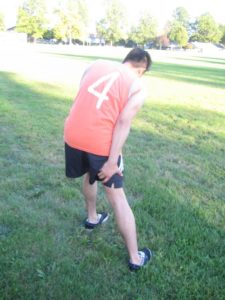Dead leg is a contusion or bruise due to direct impact. In such cases, the muscle is crushed against the thigh bone which results to swelling and bruising of the thigh muscles. The contusion can vary in severity from mild to debilitating. Similar with muscle strains, contusions are categorized as grade 1, 2 or 3 based on the severity.
- Grade 1 – tightness in the thigh while walking with a limp. There is still full range of movement if the muscle is stretched
- Grade 2 – individual could not walk properly along with occasional abrupt pangs of pain during activity. There is minimal swelling and pain is produced if the leg is straightened against resistance. Pain is also present if the injury site is pressed and inability to fully flex the knee.
- Grade 3 – unable to walk without the aid of crutches. There is intense pain and swelling. If the muscles are contracted, there is an evident bulge or gap in the muscle.
Cold therapy along with a compression wrap must be used immediately.
Close look on a dead leg
Even though the injury is often minor, it is vital that a proper diagnosis is made. A dead leg can be either intermuscular or intramuscular.
- Intramuscular – involves tearing of the muscle inside the surrounding sheath. There is initial bleeding that stops within hours due to pressure inside the muscle but the fluid could not escape due to the sheath. There is evident loss of function and discomfort that takes days or weeks to recover.
- Intermuscular – there is tearing of the muscle and a region of the surrounding sheath. The initial bleeding takes a longer time to stop especially if an ice pack is not applied. Nevertheless, the recovery is faster since the fluids can flow away from the injury site.
Management
Depending on the severity of the injury, the PRICE method (protection, rest, ice, compression, elevation) must be started right away. Cold therapy along with a compression wrap must be used immediately. It should be applied every 2 hours for 10 minutes during the initial 72 hours for severe cases of dead leg. This can stop any internal bleeding as well as reduce the swelling and pain. A compression bandage should be used to protect the injury as well as minimize the swelling. In addition, raising the affected limb allows the fluid to drain away from the area.
Sports massage can also help hasten the recovery once the acute phase has passed. Remember that if massage is started early, it might lead to severe damage including myositis ossificans.
Electrical stimulation and ultrasound are also beneficial. Even though the individual might be able to resume normal training within a few days, it is best to engage in stretching and strengthening exercise to prevent any lasting effect.
More Information / Disclaimer
The information posted on this page on a dead leg is for learning purposes only. Learn to recognize and manage muscular injuries including dead leg by taking a standard first aid course with Red Deer First Aid.

